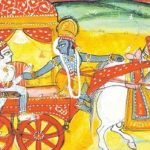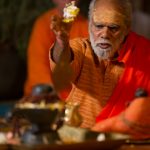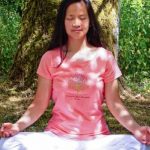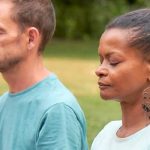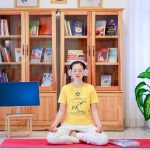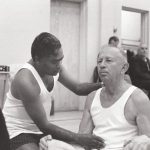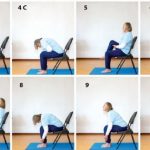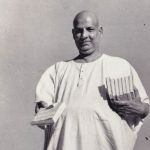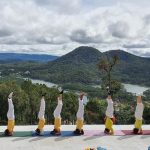 Mental Processes in Yoga
Mental Processes in Yoga
by Swami Durgananda
“How can I keep up my regular yoga practice if I live in a big city, amongst all possible circumstances of daily life, with very little time for yoga?”
 The mental capacity for yoga sadhana or spiritual practice requires preparation in daily life. Swami Vishnudevananda’s guide for spiritual practice consists of the five points: proper exercise, proper breathing, proper relaxation, proper diet, positive thinking and meditation. All of them ultimately lead to spiritual practice: concentration is developed in the yoga asanas and becomes even deeper in pranayama.
The mental capacity for yoga sadhana or spiritual practice requires preparation in daily life. Swami Vishnudevananda’s guide for spiritual practice consists of the five points: proper exercise, proper breathing, proper relaxation, proper diet, positive thinking and meditation. All of them ultimately lead to spiritual practice: concentration is developed in the yoga asanas and becomes even deeper in pranayama.
Finding the right kind of relaxation is absolutely necessary in this day and age if you want to keep your inner balance. Spiritual development is further enhanced by applying even a few principles of pure diet. The last of the five points is explicitly mental: positive thinking and meditation. In this perspective, “time for yoga” is a mental process. The yoga postures and breathing exercises keep the body sufficiently fit for mental work.
Swami Sivananda says that this mental work requires a cool head, emotional balance and a strong and healthy body. On the other hand, yoga practitioners who actually have physical ailments often do not appear as sick, and do not feel as bad as the severity of their disease would suggest; this is the power of the yogic attitude. A yogi is a person who is aware of the mental activities and knows how to direct them.
There is no mental repression in this process, as the thoughts are actually being redirected. Constantly giving in to the tendency of the senses weakens the will power. The practice of asanas and pranayama builds up the necessary energy to resist this pulling of the senses. Simple tapas or austerities protect the mind and can be integrated easily into daily life: one day without sugar or without a news – paper or other media.
The mind may try to resist and say: “I want it now”. But due to your own rational decision, the mind will not get it. Viveka, the power of discrimination, kept the upper hand. This results in a quiet state, away from the non-stop chase of “I want to possess this” and “I want to enjoy that”. As one desire is fulfilled, the next one comes up, and this happens faster than the speed of light, which is 300,000 kilometres per second.
The mind moves faster than the speed of light. We know that we are creating our future with our thoughts: what I am now corresponds to what I thought in the past, and in the future I will be what I am thinking now. So there is hope that things can change. Hate may change, greed may change. In this process of transformation there is no repression. New synapses are formed in the brain as new thoughts are repeatedly being affirmed.
“A yogi is a person who is aware of the mental activities and knows how to direct them.”
A new mode of thinking is created. Science is now able to detect thought patterns and major mental trends in the brain. Patanjali Maharishi, who formulated the principles of raja yoga, called these thoughts samskaras, thoughts which repeat themselves and form strong impressions. Both raja yoga and modern science affirm that these impressions can be changed. However it requires a great amount of mental work.
Another aspect of this mental work is a gradual awareness of your sensory perceptions. You become aware that everything you see, hear, smell, taste and touch is a relative impression. These impressions are finite. This awareness changes the way we look at the world around us. Also disease, physical impair – ments and aging will look different. The same is true for beauty and personal talents. The way we look at them changes.
You virtually take a bird’s eye view, you do not remain stuck in any sensory impression. When we come to understand that everything that surrounds us exists in exactly the same way within ourselves, that is what the masters call ‘real thinking’ or ‘cosmic thinking’. Nature constantly changes: the planets, the Milky Way, the explosions, etc. The body undergoes the same changes.
Outside we call it natural disasters, and inside these can be diseases. This type of thinking stimulates the reflection on what is infinite and what is finite, what is true and what is not true, what is permanent and what is impermanent. One begins to observe one’s own habits, for example, from where the anger arises, and you wonder how it can be overcome. One comes to the conclusion that new habits are necessary.
Master Sivananda speaks of ‘wrong’ and ‘right’ action. If the quality of the action is recognised, then new tendencies can replace the old habits. ‘Wrong’ thoughts are those which drag us down: fear, jealousy, envy, greed, etc. ‘Right’ thoughts, however, are full of joy and serenity. Negative action may have closed up certain mental functions, but it is possible to reopen them.
Negative actions or thought currents are those which do not lead to a more open, healthy worldview. Suppose, for example, there is fear of spiders. One can train oneself to overcome this phobia, by welcoming the spider when it shows up. The mental function must undergo training so that we can experience inner peace. It is possible to meet the spider peacefully rather than crushing it.
The same goes for colleagues and other people whom you may not particularly like: you can deal with them peacefully rather than crush them. This is Yoga in daily life: you may not be able to choose the people around you. And even if it all started in a positive way, the controlled and gracious behaviour that was shown at the recruitment interview may change then when there is time pressure, fatigue and work overload.
As it may not be possible to simply move away from the situation, it requires mental training to keep your balance, which in turn needs energy, and that energy can be drawn from the practice of asanas and pranayama. The mind learns not to immediately respond to everything, not immediately to be angry, not to fall immediately into the “Me” and “Mine” thought: “Why me? Why does this happen always to ME? And I, I, I …“.
That is what distinguishes great yogis. It does not really matter how long they can stand on the head or hold their breath, live without food or are able to control certain body functions. Circus artists may do this even better, but that is not the real thing. One recognises the Yogi by the equanimity, the serenity and the fresh attitude towards situations and people. He does not say, “I already know this, it is always the same problem”, and then proceed according to his own mental habits.
“It requires mental training to keep your balance, which in turn needs energy, and that energy can be drawn from the practice of asanas and pranayama.”
Habitual thought patterns veil the intuition and make it difficult to pursue new paths in an enthusiastic way. Meaningful austerity includes doing good to someone else, giving the most precious thing we have, and that is our time. Love takes time. Health takes time. Serving people takes time. Really doing a favour takes time. A really good gift for example, needs a lot of time until we find what the other person can really use and what makes him or her happy.
It is a very efficient exercise in austerity to devote time to someone else. In this way the egoism, which veils the intuition, is reduced. If we still think that we have “no time for Yoga”, then it is even more austerity to give this apparently non-existent time to others. Another remarkable exercise of spiritual practice consists in taking a few minutes to see the relativity of things and their finite nature.
It is the choice of seeing the glass half full or half empty. If intuition is covered by egoism, then the glass will always be “half empty” because greed has taken the upper hand and always wants more and more for oneself. But once you have determined that the car in the garage is not the basis for your happiness, you have taken a major step. Yoga is a science, because we experiment with ourselves.
Therefore it has nothing to do with religion, but rather with an attitude not to resign oneself to negative thinking and to cultivate the power for personal change instead. It all happens only on the mental plane. Outwardly the same things may happen as before: you get sick, you lose the job, etc., but the way you deal with it has changed, by the yogic thinking, which was developed step-by-step.
This is one of the most important aspects of the yoga practice and does not require time. All it needs is strength. It is said that the seekers of self-realisation find intuitive knowledge of who we really are and what is really going on in this universe. These intuitive revelations are the source of the yogic scriptures: the Vedas, the various Upanishads or the Bhagavad Gita. They tell us that we have a great potential, that there is great wisdom within us, and that this great bliss, ananda, may be experienced.
That is the overwhelming message of the scriptures: Yoga can be experienced. However, it requires a change of lifestyle, a transformation of habits. Actually the entire way of life has to be reviewed. Those who deal exclusively with the things which can be experienced by the senses, are veiled by the Unreal, by Maya, the illusion of life. Those who look beyond these things, turn to the Higher, the Divine.
The inner path begins when the question arises: “Who am I? What is the meaning of all this?” It is really all about personal practice. Swami Vishnudevananda often told a joke which contains a lot of truth: I am posting a sign next to my bed or in the bathroom which says: “Tomorrow I will practice asanas.” Each time you read it, it says “tomorrow“. We get entangled in many worldly concerns and it becomes difficult to untie the knot.
Only practice helps. The longer we practice with sincerity, the easier it becomes to open the knot. This condition of the human mind regarding this situation has hardly changed over the centuries. So many spiritual practices have already been offered and so many really fantastic masters have walked on this earth, but if the respective era is over, it is only history. In this regard, Swami Sivananda clearly emphasised: “Do not make a religion out of me, be practitioners.”
Getting oneself entangled in this way happens again and again, so there is no need to feel inferior and think that you are the only one to whom this happens. The whole of humanity gets itself entangled again and again. We live in this world in order to learn not to get ourselves entangled, and to recognise the entanglement and how to get out of it. In this respect the objects of the world serve as a training ground.
The objects exist in order to learn how to renounce them. This is the inner path, the necessity of the inner practice. Many practitioners do recognise the entanglement, but do not understand that this is a recurring normality. Therefore they say “I’m not yet ready for this.” It is recommended to be gentle with oneself when the entanglement comes up again, to look ahead and not to fall into apathy and lethargy, to become sleepy and disinterested with regard to the question “Who am I?”.
Swami Vishnudevananda often said that many people are actually in a permanent state of sleep with open eyes. It is true that often life situations lead to apathy and disinterest. One is only interested in one’s own area, quickly closes the door and thinks: “Let them all do what they want.” We are lacking strength and this sleepiness is often enhanced by dietary habits, alcohol and the lifestyle in general.
The time available to actually educate oneself and to be awake is quite short in one lifetime. During the four week yoga Teachers’ Training course one can see how much one is capable of achieving in a short period of time. This has to be experienced directly. Theoretical study of books cannot give this knowledge. Yoga provides an experience that you did not know before, and this experience is based on one’s own practice.
It is about the experience of real happiness that is independent of external things. It is good to remember this, so that yoga is not used exclusively on the material level, for example, to look slimmer, to be more successful or to be more relaxed. When it is seen that this inner happiness cannot be equated with money and success, then one is ready to make changes in life by making it a bit simpler.
With this the confidence in the Sadhana will grow. With practice comes experience. This goes beyond belief. You do not believe that yoga is good for you, you know it. This makes you more awake and younger. It may take a while until you have found your path and the right teaching lineage. Therefore Swami Sivananda says that perseverance is especially important.
The five points defined by Swami Vishnudevananda appear simple and below the intellectual capacities of even a beginner student. But it may actually take years until you come to under – stand that these five points contain a profound wisdom. It may well happen that one gives up the practice too early, because one does not want to hear or read always the same instructions. There is a lack of perseverance to wait and allow something to develop. The teachings have to become interwoven with daily life and that happens only through persistent practice. There is no way around it.
Taken from lectures given by Swami Durgananda in February 2015 at the Sivananda Yoga Vedanta Centres in Vienna, Berlin and Reith near Kitzbühel, Tyrol, Austria.
Swami Durgananda is Yoga Acharya (spiritual director) of the Sivananda Yoga Vedanta Centres in Europe.
e-mail: [email protected]





